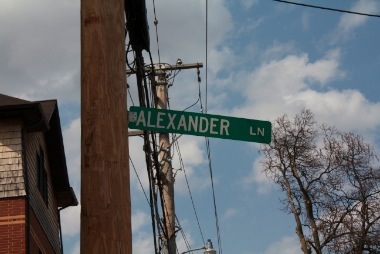
The Grand Illinois Trail uses Augusta as its route across Oak Park. This bike trail loops 500 miles across the state reaching from Lake Michigan to the Mississippi River. In Oak Park, Augusta serves as the only real probable route to cross from the east side to the west side courtesy of most of the low-traffic streets being blocked on Austin Boulevard.
Augusta itself is a mostly residential street. In its eastern reaches, most of the homes have addresses on the streets running north and south and we're left with a view of garages and back yards, although some of these reveal interesting things, such as artwork on garage doors:
or tree houses in back yards:
Just past Lombard Ave, one of the three Oak Park fire stations has its home.
The Dole branch of the Oak Park Library is located in a building owned by the city of Oak Park and shared with programs from the park district. and the HO model railroad club and a park district art studio.
The building was originally constructed as the home of North Congregational Church. In 1933, the building became the home of the Oak Park Junior College which didn't survive the depression and closed in 1938. There were rumors that the building was to be bought for use as a synagogue and in this environment it was purchased by Andrew Dole and his wife and the building donated to the village in 1939. In 1940, the library moved its north branch library from a pharmacy at the corner of Ridgeland and Chicago.
Further down Augusta at number 414, is one of the homes in which Edgar Rice Burroughs lived while he resided in Oak Park.
I found this garage with its connected green house to be charming.
Further down Augusta is the Norman Smith House, built in 1927, designed by Graham, Anderson, Probst and White, the architectural team responsible for such notable Chicago landmarks as a the Civic Opera House, the Wrigley Building and Merchandise Mart
This house, built in 1912, by Carl Linder shows the influence of the prairie style of architecture on its design. Note the broad horizontal lines of the home and the symmetrical single-story wings on either side of the two-story edifice.
Also on Augusta is Frank Lloyd Wright's Harry S. Adams home.
This is the last Wright home built in Oak Park. Adams rejected Wright's original plans for the home several times because of the cost of building the home, at one point turning to another architect to design the home at which point, perhaps out of a feeling of jealousy and rejection, Wright provided the final plans for the home as it was built.
RIght next door is a gorgeous mid-century modern home designed by Arthur Myrhum. The horizontal lines give it a sense of conversation with the Wright's design and its clean geometry manage to make it appear as if it were designed for the asian accents the current owner has added to the landscaping.
A 1927 Lowenberg & Lowenberg home designed in renaissance style looks nice in isolation (I especially like the arch work on the front façade), but has little relation to the surrounding homes.
I rather like the way this 1896 Queen Anne-style home was modernized.
This home, built in 1929 was designed by John Malina for himself.
A pair of twin duplexes built in 1916 for A. D. Lurinow.
Proof that not everything on Augusta is historical. There are touches, like the ground-floor bay window that make this home look like it has the bones of an older home, but it doesn't appear in the inventory of the Frank Lloyd Wright historical district. Certainly the attached garage would be an addition, but I suspect that the whole home is of relatively recent construction.






















 Many of the buildings with addresses on Adams Street are tacked onto lots which have been split in half with the alley half of the lot getting the Adams address. This is not always a recent phenomenon as this older apartment building demonstrates.
Many of the buildings with addresses on Adams Street are tacked onto lots which have been split in half with the alley half of the lot getting the Adams address. This is not always a recent phenomenon as this older apartment building demonstrates.

 No doubt, it was the wonderful spring weather which was marked also by the arrival of new tulips planted in the parkway.
No doubt, it was the wonderful spring weather which was marked also by the arrival of new tulips planted in the parkway.
 Because there are so few buildings with addresses on Adams Street, I can safely say that this is the only single family residence with an Adams Street address (everything else is an apartment building).
Because there are so few buildings with addresses on Adams Street, I can safely say that this is the only single family residence with an Adams Street address (everything else is an apartment building).
